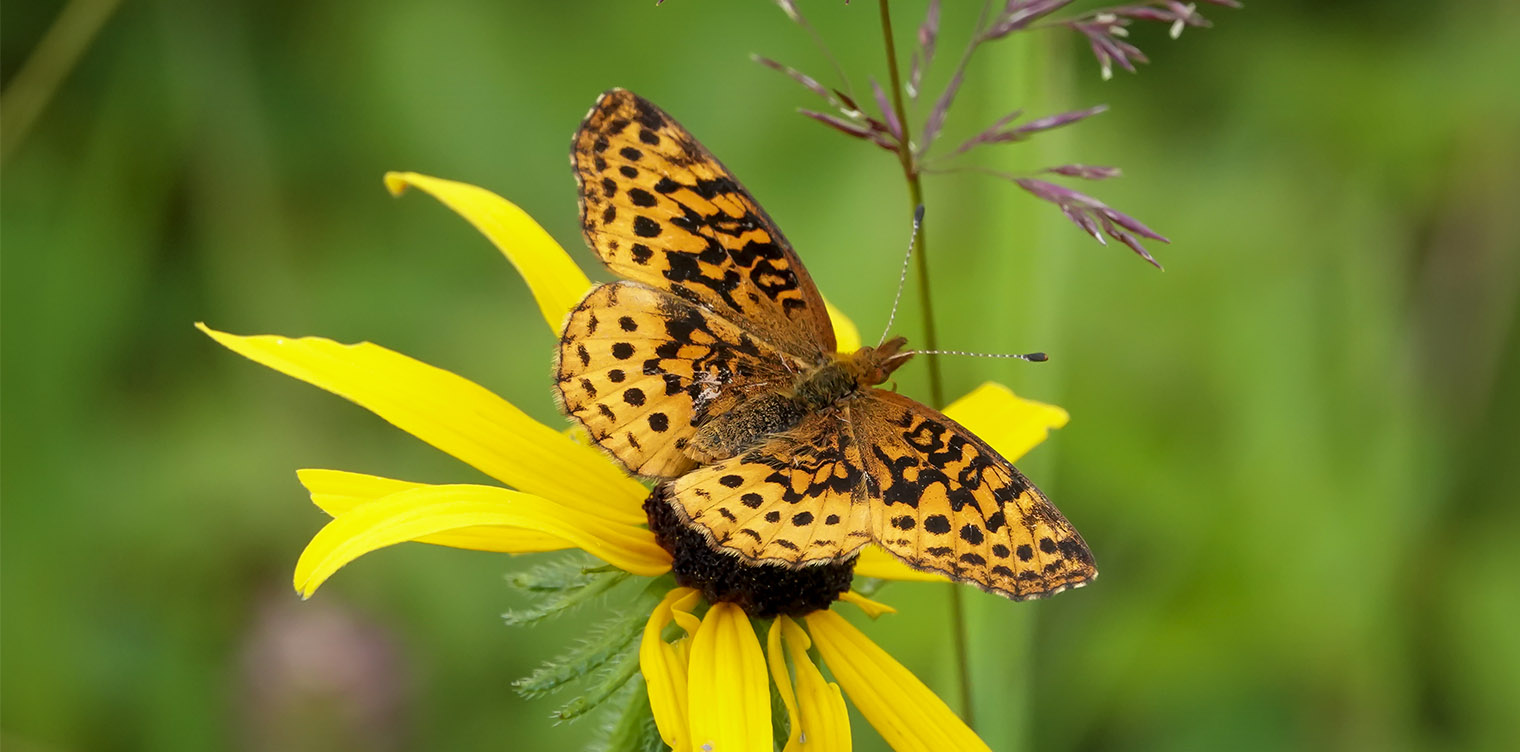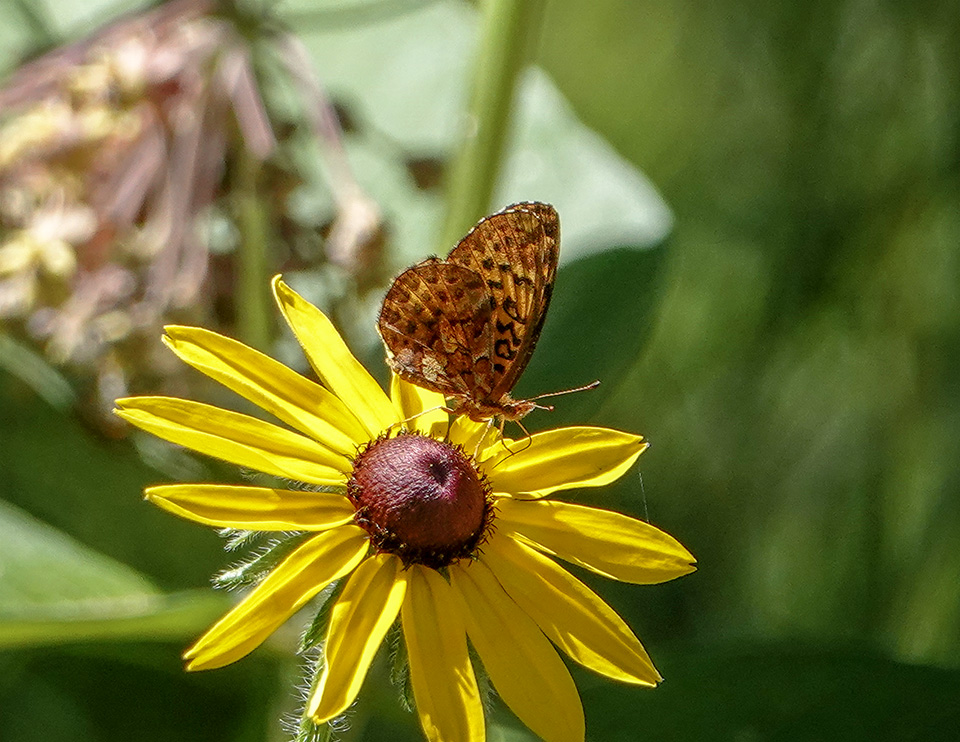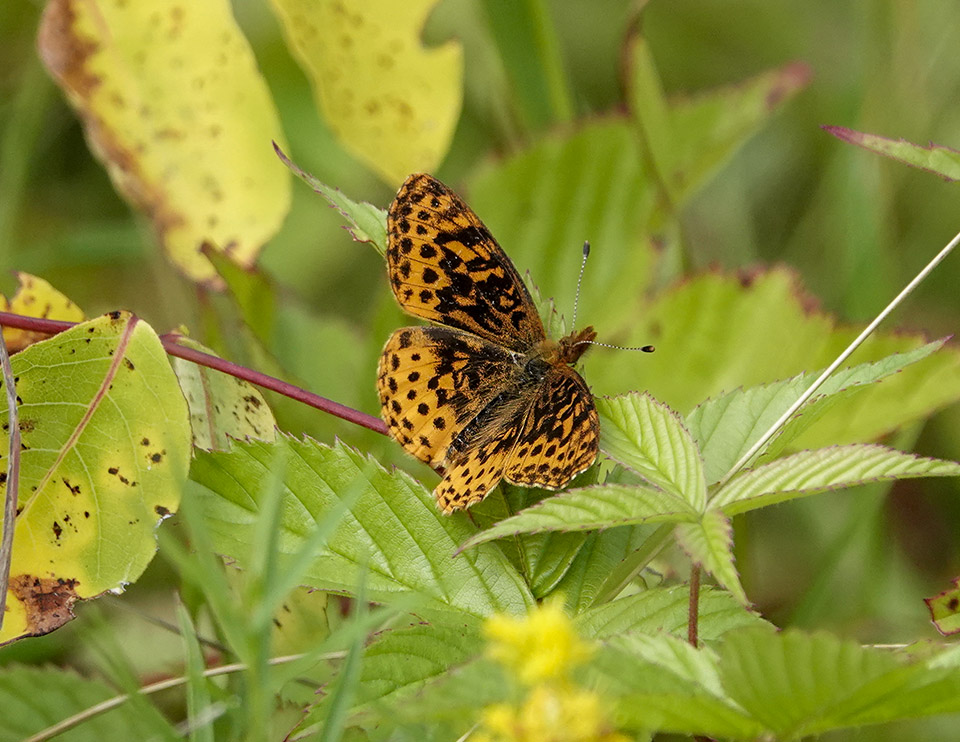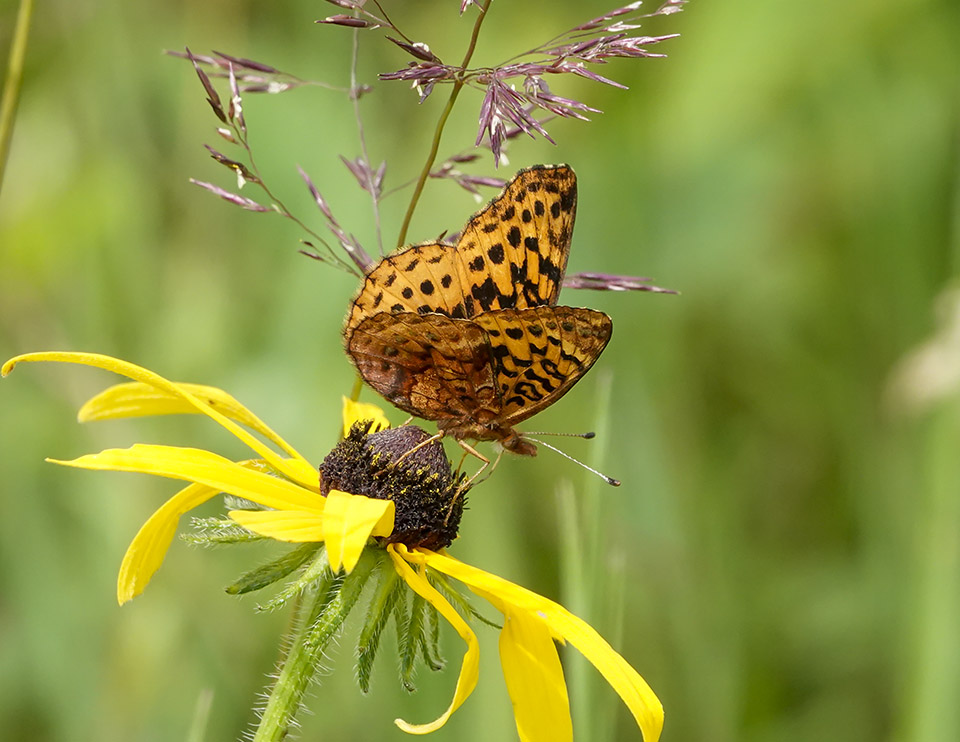Butterflies of the Adirondacks:
Meadow Fritillary (Boloria bellona)

The Meadow Fritillary (Boloria bellona) is a small orange and black butterfly usually seen in the Adirondack Mountains of upstate New York in late summer.
- The Meadow Fritillary is a member of the Brush-footed family of butterflies (Nymphalidae) – a large family of butterflies often some shade of orange in color with reduced fore legs. These butterflies have large prominent knobs on their antennae. This family includes fritillaries, checkerspots, admirals, and painted ladies. [1]
- The Meadow Fritillary is one of the lesser fritillaries, a group which also includes the Silver-bordered Fritillary. [2]
Meadow Fritillary: Identification

The Meadow Fritillary is one of the smaller fritillaries, with a wingspan of 1¼ to 1⅞ inches. [3] [4]
- From above, this species is orange-red, with heavy black markings. The submarginal brown triangles on the hindwing are pointed inward.
- From below, the Meadow Fritillary is heavily patterned with orange and purple-brown. The trailing edge of the hindwing lacks a dark border.
- The forewing of this butterfly is squared off, giving the wing a truncated tip. [5] [6]
The Meadow Fritillary might be mistaken for several other orange and black species found in the Adirondacks.
- The Meadow Fritillary is quite similar in coloring and size to the Silver-bordered Fritillary, which is found in similar habitats in the Adirondack Park. The two species can be distinguished by the Meadow's blunt and slanted forewing tip and also by the fact that the hindwing from below lacks the silvery spots of the Silver-bordered Fritillary. [7]
- The Meadow Fritillary is significantly smaller than the greater fritillaries commonly seen in the Adirondack Park: Aphrodite Fritillary, Atlantis Fritillary, and Great-Spangled Fritillary.
- Both the Northern Crescent, and the Pearl Crescent, which are also seen in the Adirondacks, have more black on the wings. [8]
- The Harris' Checkerspot is much darker above and is significantly larger than the Meadow Fritillary. [9]
Meadow Fritillary: Life History

Male Meadow Fritillaries patrol meadows during the daylight hours, usually flying low to the ground. [10] Females lay their eggs on twigs, grass stems, and other plants, laying as many as 85 eggs singly. The eggs, which are greenish yellow, hatch in about five to seven days. [11]
The resulting caterpillars (larvae) are dark with yellow and black mottling and yellowish-brown spines. [12] The caterpillars, which reportedly are found March-April and again June to August, feed on violets. [13] The chrysalis is yellowish brown. [14]
Adult Meadow Fritillaries feed on nectar from a variety of plants, including Black-eyed Susans, dandelions, and Ox-eyed Daisies. [15] The Meadow Fritillary's flight pattern is usually described as rapid, low, and jerky. [16]
Meadow Fritillary: Habitat and Range
Meadow Fritillaries are, as the name implies, butterflies of open meadows, favoring areas such as pastures, grassy fields, hay fields, old beaver meadows, and mown areas on roadsides. [17] The Meadow Fritillary is said to be more adaptable than the similar Silver-bordered Fritillary, and can survive in disturbed habitats. [18] [19] [20] Although some sources indicate that Meadow Fritillaries prefer wet meadows, [21] in our region this species can be found in dry meadows as well.
The range of the Meadow Fritillary covers eastern British Columbia east through southern Canada and the northern part of the US to Newfoundland, south to north central Oregon, central Colorado, northeast Tennessee, and northwest North Carolina. [22] This species is found throughout the Northeast and New England. [23] It is said to have significantly expanded its range southward in recent years. [24]
Meadow Fritillary: Flight

The flight period of Meadow Fritillaries, as with all butterflies, varies with region and shifts from year to year. The Meadow Fritillary is said to have two to three broods flying from late April to mid-October. [25]
- In Wisconsin, the Meadow Fritillary reportedly has two broods and is seen from early May through September. [26]
- In Massachusetts, there are reportedly three flights. The first is from early May to late June. The second is from early to late July. The third is from early August to September. [27]
- In Vermont, there also appears to be at least three flights, with each one overlapping slightly with the next. [28]
- In the New York City region of New York State, the Meadow Fritillary flies from late-April through mid-September, with the greatest abundance in mid-June to mid-July and then again in late August. [29]
The flight period and abundance of the Meadow Fritillary within the Adirondack Park can only be roughly estimated, based mainly on a very limited number of verified sightings on Butterflies and Moths of North America (BAMONA) and reported observations on iNaturalist.
- The advantage of iNaturalist is that it is a popular citizen science web site that attracts many observers, in part because it covers both plants and animals and in part because the process of submitting an observation is very easy. The disadvantage is that an individual observation can achieve "research-grade" status by being confirmed by the observer and one additional individual, who may or may not have expertise in that particular taxa.
- The advantage of BAMONA is that sightings are verified by regional specialists who are recognized experts. The disadvantage is that there are fewer sighting records for most species, partly because the site covers only butterflies and moths and partly because the process of submitting a sighting is more complicated.
- Both data sets share a common problem of citizen science: reported trends may reflect trends in the number of observers and their willingness to submit reports, not the abundance of the butterfly in question. In addition, the Meadow Fritillary is so similar in size and color pattern to the Silver-bordered Fritillary that it is difficult to identify with confidence without a clear view. As a result, the number of recorded sightings probably does not reflect this species' abundance.
With these caveats in mind, it appears that Meadow Fritillaries are most frequently seen in the Adirondack region in late July and late August.
- Meadow Fritillaries have not been frequent guests at the Paul Smith's College VIC Native Species Butterfly House. This species was not listed as being present in the Species Logbooks for 2012, 2013, 2015, or 2016. [30]
- BAMONA lists only a few verified sightings for Meadow Fritillaries in the Adirondack Park, with sightings in mid-June, late July, late August, and early September. [31]
- Similarly, there have been few observations of Meadow Fritillaries in iNaturalist. [32] [33] In 2016, there was only one Adirondack Park iNaturalist observation, in late July. [34] In 2017, there were no observations. [35] in 2018, there were two iNaturalist observations for the Adirondack region, both in late July. [36] In 2019, four Adirondack Park observations were recorded, in late July, late August, and early September. [37] In 2020, there were 16 observations of Meadow Fritillaries, most in July and August. [38]
References
- Susan Grimm Hanley. Interpretive Naturalist, Paul Smith's College Native Species Butterfly House. Species Logbooks.
- Butterflies and Moths of North America. Species Profiles. Meadow Fritillary. Retrieved 2 September 2019.
- Butterflies and Moths of North America. Sighting Records. Meadow Fritillary. 6/18/2018; 7/21/2019; 8/30/2019; 9/1/2019. Retrieved 2 September 2019.
- iNaturalist. Adirondack Park Sightings. Meadow Fritillary. Retrieved 2 September 2019.
- Naturalist. Adirondack Park Sightings. Silver-bordered Fritillary. Retrieved 4 September 2019.
- iNaturalist. Adirondack Park Sightings 2016. Meadow Fritillary. Retrieved 2 September 2019.
- iNaturalist. Adirondack Park Sightings 2017. Meadow Fritillary. Retrieved 2 September 2019.
- iNaturalist. Adirondack Park Sightings 2018. Meadow Fritillary Retrieved 2 September 2019.
- iNaturalist. Adirondack Park Sightings 2019. Meadow Fritillary. Retrieved 27 May 2021.
- iNaturalist. Adirondack Park Sightings 2020. Meadow Fritillary. Retrieved 27 May 2021.
- Government of Canada. Canadian Biodiversity Information Facility. Species Bank. Meadow Fritillary. Boloria bellona. Retrieved 2 September 2019.
- Massachusetts Butterfly Club. Massachusetts Butterfly Species List. Meadow Fritillary. Boloria bellona. Retrieved 2 September 2019.
- Massachusetts Audubon. Butterfly Atlas Species Accounts. Meadow Fritillary. Boloria bellona. Retrieved 2 September 2019.
- Kent P. McFarland and Bryan Pfeiffer. Vermont Butterfly Survey. Vermont Center for Ecostudies – Vermont Atlas of Life. Meadow Fritillary. Boloria bellona. Retrieved 2 September 2019.
- Integrated Taxonomic Information System On-line Database. Boloria bellona. Retrieved 3 September 2019.
- Iowa State University. Department of Entomology. BugGuide. Boloria bellona. Retrieved 3 September 2019.
- Wisconsin Butterflies. Boloria bellona. Retrieved 3 September 2019.
- The Butterflies of Massachusetts. Meadow Fritillary. Boloria bellona. Retrieved 3 September 2019.
- Montana Field Guides. Meadow Fritillary. Boloria bellona. Retrieved 3 September 2019.
- Ross Layberry, Peter Hall, and Don Lafontaine. The Butterflies of Canada (University of Toronto Press, 1998), pp. 48-49.
- Thomas J. Allen, Jim P. Brock, James P. Brock, Jeffrey Glassberg. Caterpillars in the Field and Garden: A Field Guide to the Butterfly Caterpillars of North America (Oxford University Press, 2005) pp. 82-83.
- National Audubon Society. Field Guide to Butterflies (New York: Alfred A. Knopf, 1981), pp. 537-538, 560-561, Plate 614.
- Jeffrey Glassberg. Butterflies of North America (Sterling Publishing Company, 2011), p. 130.
- Jeffrey Glassberg. Butterflies through Binoculars. The East. A Field Guide to the Butterflies of Eastern North America (Oxford University Press, 1999), p. 108, Plate 29.
- Jeffrey Glassberg. A Swift Guide to Butterflies of North America. Second Edition. (Princeton University Press, 2017), p. 182.
- Jim P. Brock and Kenn Kaufman. Kaufman Field Guide to Butterflies of North America (Houghton Mifflin, 2003), pp. 168-169.
- Paul A. Opler. A Field Guide to Eastern Butterflies (The Peterson Field Guide Series, Houghton Mifflin Company, 1992,1998), pp. 78-79, 243-244.
- James A. Scott. The Butterflies of North America. A Natural History and Field Guide (Stanford University Press, 1986), pp. 320-321.
